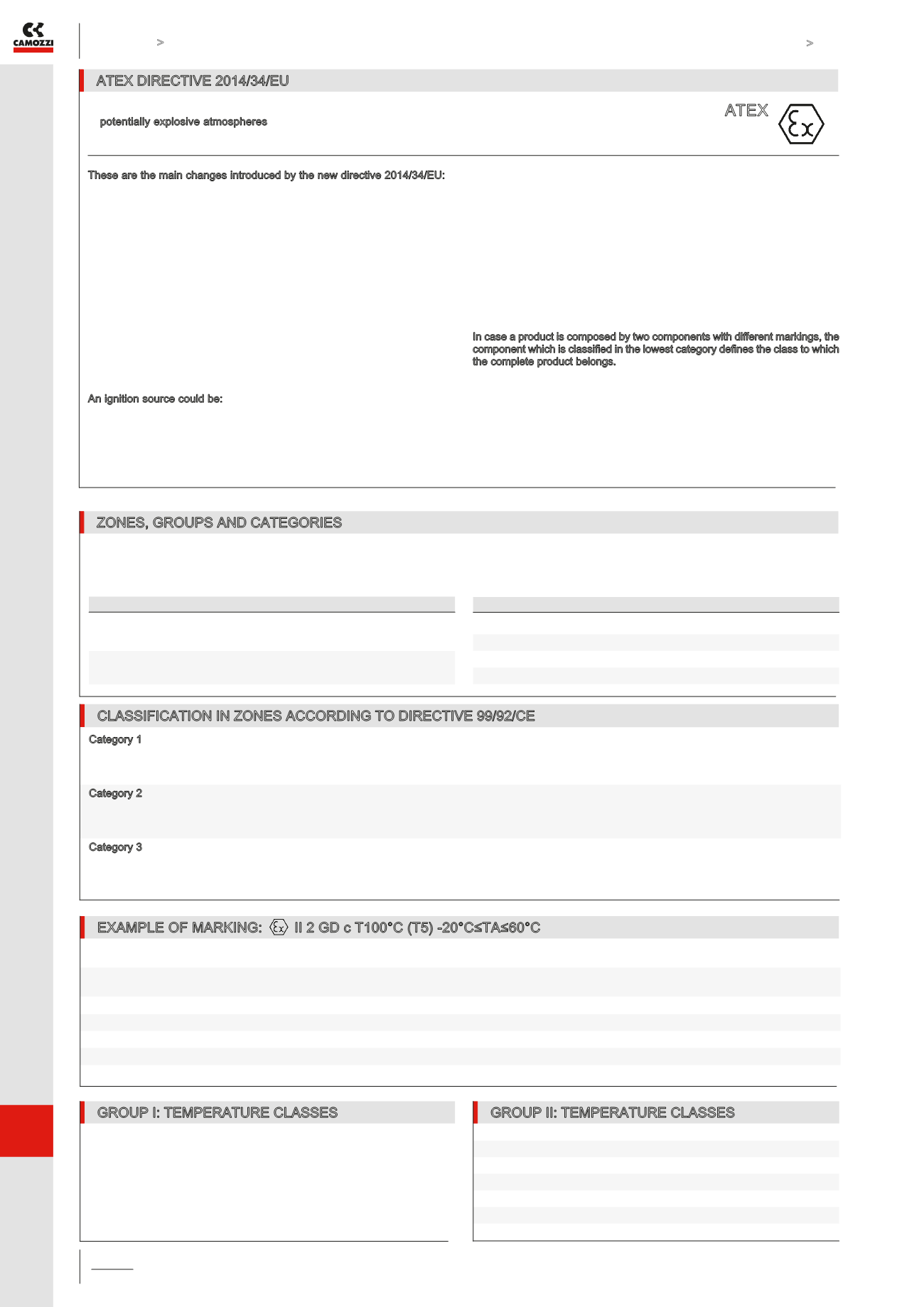

C_FLUID CONTROL CATALOGUE
>
2018
General terms and conditions for sale are available on
www.camozzi.com.a
APPENDIX
APPENDIX >
Info
2014/34/EU
ATEX
ATEX DIRECTIVE 2014/34/EU
ZONES, GROUPS AND CATEGORIES
As from 19 April 2016 all products which are commercialised in the European Union and destined to be used
in potentially explosive atmospheres have to be approved according to the directive 2014/34/EU, also known as ATEX.
This new directive also refers to non-electric items, like pneumatic drives, which need to be approved.
These are the main changes introduced by the new directive 2014/34/EU:
• Also non-electric apparatus
and devices, as pneumatic cylinders, are part of the Directive
• The apparatus are assigned to different categories which are assigned to
certain potentially explosive zones.
• The products are identified with the CE mark Ex.
• The instructions for use and the declarations of conformity should in order
to be supplied with each sold product used in potentially explosive zones.
• Products destined to be used in potentially explosive zones, because of the
presence of dust, are included in the directive like the products destined to
be used in zones with the presence of dangerous gases.
A potentially explosive atmosphere could be composed of gas, mist, steam
or dust which can be created in manufacturing processes or in all those
areas in which there is a constant or random presence of inflammable
substances.
An explosion can occur when there is an existing presence of inflammable
substances and an ignition source in a potentially explosive atmosphere.
An ignition source could be:
• Electrical (electric arcs, induced current, heat generated by the Joule effect)
• Mechanical (heat between surfaces caused by friction, sparks generated
by the collision of metallic bodies, electrostatic discharges, adiabatic
compression)
• Chemical (exothermic reactions between materials)
• Naked flames.
In the places and for the types of equipment subject to Directive 99/92/CE, the employer should execute the classification of the zones regarding the danger of
the creation of explosive atmospheres because of the presence of gas or dust. The apparatus for the use in potentially explosive zones are divided in GROUPS:
GROUP I > apparatus used in mines
GROUP II > apparatus used in installations above the ground
The products which are subject to the approval are those which, during
their normal use or because of a malfunction, present one or more ignition
sources for the potentially explosive atmospheres.
The producer has to guarantee that the product conforms with the
declarations and to the marking of the product.
Moreover the product should always be accompanied by the relative
instructions.
The builder of the equipment and/or user should identify the risk zone
in which the products, to which directive 99/92/CE refers, are used and
purchase the product according to the use in the pre-determined zone paying
attention to the specifications in the relative instructions.
In case a product is composed by two components with different markings, the
component which is classified in the lowest category defines the class to which
the complete product belongs.
Example:
solenoid suitable for Category 3 marked …
Ex - II 3 EEx…
and valve suitable for Category 2 …
Ex - II 2 EEx…
The valve unit with solenoid can be used only in category 3 or zone 2/22
a
/2
11
II
Group: Devices which are to be used in spaces exposed to risks of an explosive atmosphere, different from underground spaces, mines, tunnels,
etc., individuated according to the criteria in enclosure I of the Directive 94/9/CE (ATEX)
2
Category: Devices designed to function in compliance with the operational parameters determined by the manufacturer and guarantee a high
protection level
GD Protected against gas (G) and explosive powders (D)
c
Non-electrical constructions for potentially explosive atmospheres. Protection through constructive security
T 100°C Max. superf. temp. of 100 °C reg. potential hazards resulting from striking within the vicinity of hazardous powders
T5
Max. superf. temp. of 100 °C regarding potential hazards which may result from striking within gassy environments
Ta
Environmental temperature: -20°C≤Ta≤60°C. Environmental temperature range (with dry air)
EXAMPLE OF MARKING: II 2 GD c T100°C (T5) -20°C≤TA≤60°C
Temp. classes for gas (G)
Admissible surface temperatures
T1
450°C
T2
300°C
T3
200°C
T4
135°C
T5
100°C
T6
85°C
GROUP I: TEMPERATURE CLASSES
GROUP II: TEMPERATURE CLASSES
Temperature =150 °C
or = 450 °C according to the level
of dust on the apparatus.
Category 1 Zone 0 -
Zone 20 -
Area in which (permanently, for long periods or often) an explosive atmosphere is present, consisting of a mixture of air and inflammables
in the form of gas, vapour or mist.
Area in which (permanently, for long periods or often) an explosive atmosphere is present in the form of a dust/powder cloud which is
combustible in the air.
Category 2 Zone 1 -
Zone 21 -
Area in which, during normal activities, the formation of an explosive atmosphere is probable, consisting of a mixture of air and inflammables
in the form of gas, vapours or mist.
Area in which occasionally during normal activities the formation of an explosive atmosphere is probable, in the form of a dust/powder cloud
which is combustible in the air.
Category 3 Zone 2 -
Zone 22 -
Area in which, during normal activities, the formation of an explosive atmosphere, consisting of a mixture of air and inflammables in the form
of gas, vapour or mist is not probable and, whenever this should occur, it is only of a short duration.
Area in which, during normal activities, the formation of an explosive atmosphere in the form of a combustible dust/powder cloud is not probable
and, whenever this should occur, it is only of a short duration.
CLASSIFICATION IN ZONES ACCORDING TO DIRECTIVE 99/92/CE
CATEGORY M1
Functioning in explosive atmosphere
CATEGORY M2
Non-supplied equipment in explosive atmospheres
PRODUCT CATEGORY GAS
DUST
1
Zone 0
Zone 20
2
Zone 1
Zone 21
3
Zone 2
Zone 22
GROUP I: APPARATUS FOR MINES
GROUP II: APPARATUS FOR INDUSTRIES ABOVE THE GROUND



















